  
Chapter II Illustrations and Explanations
of the Exercise Movements
(Fo Zhan Qianshou
Fa)[1]
Principles: At the core of
Buddha Stretching a Thousand Arms is stretching of the body. This stretching
unblocks areas where energy is congested, stimulates the energy in the body and
under the skin so that it circulates vigorously, and automatically absorbs a
great amount of energy from the universe. This enables all of the meridians in a
cultivator’s body to open up from the start. When you perform this exercise, the
body will have a special feeling of warmth and of the existence of a strong
energy field. This is caused by the stretching and opening of all meridians
throughout the body. Buddha Stretching a Thousand Arms is composed of eight
movements. The movements are quite simple, yet they control many things that are
evolved by the cultivation method as a whole. At the same time, they enable
cultivators to quickly enter the state of being surrounded by an energy field.
Cultivators should perform these movements as a foundational exercise. They are
usually done first, and are one of the reinforcing methods for your
cultivation.
Verse:[2]
Shenshen Heyi[3]
Dongjing Suiji[4]
Dingtian
Duzun
Qianshou
Foli
Preparation – Stand naturally
with the feet shoulder-width apart. Bend both knees slightly. Keep the knees and
hips relaxed. Relax the whole body, but don’t become too loose. Tuck the lower
jaw in slightly. Touch the tip of the tongue to the hard palate, leave a space
between the upper and lower teeth, and close the lips. Gently close the eyes.
Maintain a serene expression on the face.
Conjoining the Hands (Liangshou Jieyin) – Lift both hands slightly with
the palms facing up. Have the thumb tips lightly touch each other. Let the other
four fingers of each hand meet and overlap on top of each other. For males, the
left hand goes on top; for females, the right hand goes on top. Have the hands
form an oval shape and hold them at the lower abdominal area. Hold both upper
arms slightly forward with the elbows rounded so that the underarms are open
(Figure 1-1).
Buddha Maitreya Stretching His Back
(Mile Shenyao )[7] – Starting from Jieyin,[8]
raise both hands upward. When the hands reach the front of the face, separate
them and gradually turn the palms upward. When the hands are above the top of
the head, have the palms face up. Point the fingers of both hands toward each
other (Figure 1-2), with a distance of 20 to 25 cm (8
to 10 inches ) between them. At the same time, press upward with the heels
of both palms, push the head upward, press the feet downward, and stretch the
whole body. Stretch for about 2 to 3 seconds, and then relax the whole body
abruptly. Return the knees and hips to a relaxed position.
   
Tathagata[9]
Pouring Energy into the Top of the Head (Rulai
Guanding)[10] –
Following from the previous movement (Figure 1-3), both hands go outward, and
turn your palms 140° to form a funnel shape. Straighten the wrists and move them
downward. As the hands move down, keep the palms facing the chest at a distance
of no more than 10 cm (4 inches). Continue moving
both hands towards the lower abdomen (Figure 1-4).
Pressing the Hands Together in
Front of the Chest (Shuangshou Heshi)[11]
– At the lower abdomen, turn the backs of the hands to face
each other, and without pausing, lift the hands up to the chest to form Heshi (Figure 1-5).
When doing Heshi, press both the fingers and the heels of the
palms against each other, leaving a hollow space in the center of the palms.
Hold the elbows up, with the forearms forming a straight line. (For all of the
exercises, keep the hands in the Lotus Palm position [12]
except when doing Heshi and Jieyin).
   
Hands Pointing to Heaven and Earth
(Zhangzhi Qiankun)[13]
– Starting from Heshi, separate the hands about 2 to 3 cm (1 inch) (Figure
1-6) and turn them in opposite directions. Males, turn the left hand (females,
turn the right hand) towards the chest and turn the right hand forward, so that
the left hand is on top and the right hand is on the bottom. Both hands should
make a straight line with the forearms. Then, extend the top forearm diagonally
upward (Figure 1-7). Have its palm facing down and as high as the head. Keep the
other hand in front of the chest with the palm facing up. After the top arm
reaches the proper position, push the head upward, press the feet downward, and
stretch the entire body to its limits. Stretch for about 2 to 3 seconds, then
relax the entire body abruptly. Return the top hand to the front of the chest
and form Heshi
(Figure 1-5). Next, turn the hands in the opposite directions from the first
time, so that the opposite hand is on top and the hand that was on top before is
underneath (Figure 1-8). Extend the top hand and repeat the previous movements of the bottom hand
(Figure 1-9). After stretching, relax the whole body. Move the hands in front of
the chest to Heshi.
 
Golden Monkey Splitting its Body
(Jinhou Fenshen)
– Starting from Heshi, extend the arms outward on the sides of the
body, forming a straight line from the shoulders. Push the head upward, press
the feet downward, and straighten the arms on each side. Stretch outward in four
directions, using force throughout the whole body (Figure 1-10). Stretch for
about 2 to 3 seconds. Abruptly relax the entire body and form Heshi.
Two Dragons Diving into the Sea (Shuanglong Xiahai)
[15]
– Starting from Heshi, separate the hands and extend
them downward towards the lower front of the body. When the arms are parallel
and straight, the angle between the arms and the body should be about 30°
(Figure 1-11). Push the head upward, press the feet downward, and stretch the
whole body, using force. Stretch for about 2 to 3 seconds, then immediately
relax the entire body. Move the hands to Heshi in front of the chest.
Bodhisattva
Touching the Lotus (Pusa
Fulian) – Starting from Heshi, separate both hands while extending them
diagonally downward to the sides of the body (Figure 1-12). Straighten the arms
so that the angle between the arms and the body is about 30°. Simultaneously
push the head upward, press the feet downward, and stretch the entire body using force. Stretch for about 2 to 3 seconds, then
relax the whole body abruptly. Move the hands to Heshi in front of
the chest.
  
Arhat[18]
Carrying a Mountain on His Back (Luohan Beishan)
– (Figure 1-13) Starting from Heshi, separate the
hands while extending them behind the body. At the same time, turn both palms to
face backward. As the hands pass the sides of the body, slowly bend the wrists
upward. When the hands arrive behind the body, the angle between the wrists and
the body should be 45°. At this point, push the head upward, press the feet
downward and stretch the entire body using force. (Keep the body upright—don’t
lean forward, but stretch from the chest.) Stretch for about 2 to 3 seconds,
then relax the whole body abruptly. Move the hands to Heshi in front of
the chest.
Vajra
Toppling a Mountain (Jingang Paishan)
–From Heshi, separate both hands while pushing
forward with the palms. Have the fingers pointing upwards. Keep the hands and
shoulders at the same level. Once the arms are extended, push the head upward,
press the feet downward, and stretch the whole body using force (Figure 1-14).
Stretch for about 2 to 3 seconds, then immediately relax the entire body. Move
the hands to Heshi.
Overlapping the Hands in Front of the Lower Abdomen (Diekou
Xiaofu) – Starting from Heshi, slowly move the hands downward, turning the
palms towards the abdominal area. When the hands reach the lower abdomen, place
one hand in front of the other (Figure 1-15). Males should have the left hand
inside; females should have the right hand inside. Have the palm of the outer
hand face the back of the inner hand. The distance between the hands, as well as
between the inner hand and the lower abdomen, should each be about 3 cm (1 inch). Usually
the practitioner overlaps the hands for 40 to 100 seconds.
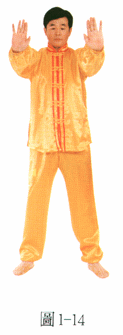  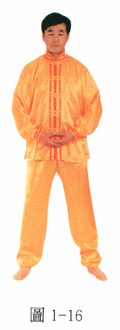
Closing Position –
Conjoin the hands (Shuangshou Jieyin) (Figure 1-16).
(Falun Zhuang Fa)[23]
Principle: Falun Standing Stance is a still, standing meditation
composed of four wheel-holding positions. Frequent performance of Falun Standing
Stance will facilitate the complete opening of the entire body. It is a
comprehensive means of cultivation that enhances wisdom, increases strength,
raises a person’s level, and strengthens supernatural powers. The movements are
simple, but much can be achieved through the exercise. Beginners’ arms may feel
heavy and achy. After doing the exercises, though, the whole body will
immediately feel relaxed, without feeling the kind of fatigue that comes from
physical work. When cultivators increase the time and frequency of the exercise,
they can feel a Law Wheel rotating between the arms. The movements of Falun
Standing Stance should be done naturally—don’t intentionally pursue swaying. It
is normal to move slightly, but obvious swaying should be controlled. The longer
the exercise time, the better, but everyone is different. After you reach a
state of calm, don’t lose awareness that you are exercising, but instead
maintain it.
Verse:
Shenghui Zengli[24]
Rongxin Qingti[25]
Simiao Siwu[26]
Falun Chuqi[27]
Preparation – Stand naturally
with feet shoulder-width apart. Bend both knees slightly. Keep the knees and
hips relaxed. Relax the whole body, but don’t become too loose. Tuck the lower
jaw in slightly. Touch the tip of the tongue to the hard palate, leave a space
between the upper and lower teeth, and close the lips. Gently close the eyes.
Maintain a serene expression on the face.
Conjoin the hands (Liangshou Jieyin) (Figure
2-1)
Holding the Wheel in Front of the
Head (Touqian Baolun)
– Start from Jieyin (the conjoined hand position). Slowly raise both
hands from the abdomen, separating them in the process. When the hands are in
front of the head, the palms should point towards the face at eyebrow level
(Figure 2-2). Have the fingers of the hands pointing towards one another, with a distance of 15 cm (6 inches) between
them. Form a circle with the arms. Relax the whole body.
  
Holding the Wheel in Front of the
Lower Abdomen (Fuqian
Baolun) – Slowly move both hands downward. Keep the arms in the
wheel-holding position as they reach the lower abdominal area (Figure 2-3). Hold
both elbows forward, keeping the underarms open. Keep the palms facing upward,
the fingers pointing toward one another, and the arms in the shape of a
circle.
Holding the Wheel Above the
Head (Touding Baolun)
– While maintaining the wheel-holding position, slowly raise
the hands until they are over the head (Figure 2-4). Have the fingers of both
hands pointing toward one another, and the palms facing downward. Keep a
distance of 20 to 30 cm (8 to 12 inches) between the fingertips of both hands.
Have the arms form a circle. Keep the shoulders, arms, elbows, and wrists
relaxed.
Holding the Wheel on Both Sides of
the Head (Liangce
Baolun) – Starting from the previous position, move both hands
downward next to the sides of the head (Figure 2-5). Keep the palms facing the
ears, with both shoulders relaxed and the forearms upright. Don’t keep the hands
too close to the ears.
   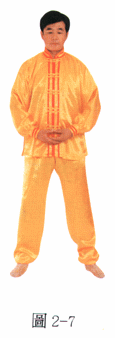
Overlapping the Hands in Front of the Lower Abdomen (Diekou Xiaofu)
(Figure 2-6) – Move the hands downward to the lower abdomen. Overlap the
hands.
Closing Position –
Liangshou Jieyin (Conjoin the hands) (Figure
2-7).
(Guantong Liangji Fa)[32]
Principle: Coursing Between the Two Poles channels the universe’s
energy and mixes it with the energy inside your body. A great amount of energy
is expelled and taken in during this exercise, enabling a cultivator to purify
his or her body in a very short time. At the same time, the exercise opens the
meridians on top of the head and unblocks the passages underneath the feet. The
hands move up and down according to the energy inside the body and the
mechanisms outside the body. The upward-moving energy dashes out of the top of
the head and travels directly to the upper pole of the universe; the
downward-moving energy is ejected out from the bottom of the feet and rushes
directly to the lower pole of the universe. After the energy returns from both
poles it is then emitted in the opposite direction. The hand movements are done
nine times.
After the one-handed gliding up and down movements are done
nine times, both hands are to glide up and down nine times. Then, the Law Wheel
is turned clockwise four times in front of the lower abdomen in order to spin
the outside energy into the body. The movements end by conjoining the
hands.
Before doing the exercise, imagine you are two empty
barrels, standing upright between heaven and earth, gigantic and incomparably
tall. This helps channel the energy.
Verse:
Jinghua Benti[33]
Fakai Dingdi[34]
Xinci Yimeng[35]
Tongtian Chedi[36]
Preparation – Stand naturally with feet shoulder-width apart. Bend both
knees slightly. Keep the knees and hips relaxed. Relax the whole body, but don’t
become too loose. Tuck the lower jaw in slightly. Touch the tip of the tongue to
the hard palate, leave a space between the upper and lower teeth, and close the
lips. Gently close the eyes. Maintain a serene expression on the face.
Conjoin the Hands (Liangshou Jieyin) – (Figure 3-1)
Press the Hands Together in Front
of the Chest (Shuangshou
Heshi) – (Figure 3-2)
   
One-Handed Gliding Up-and-Down
Movement (Danshou
Chong'guan) – From Heshi, simultaneously glide one hand upward and the
other hand downward. The hands should glide slowly along with the energy
mechanisms outside the body. The energy inside the body moves up and down
simultaneously with the hand movements (Figure 3-3). Males start by gliding the
left hand upward; females start by gliding the right hand upward. Pass that hand
in front of the face and extend it above the head. Meanwhile, slowly lower the
right hand (females, the left hand). Then switch the positions of the hands
(Figure 3-4). Keep the palms facing the body at a distance of no more than 10 cm
(4 inches). Keep
the entire body relaxed. One up-and-down movement of each hand is one count.
Repeatedly glide the hands up and down for nine counts.
Two-Handed Gliding Up-and-Down
Movement (Shuangshou Chong'guan)
– After the one-handed gliding up and down movement, keep the left hand (right
hand for females) up and waiting, and slowly bring the other hand up so that
both hands are pointing upward (Figure 3-5). Then slowly glide both hands
downward at the same time (Figure 3-6).
When gliding both hands up and down, keep the palms facing
the body at a distance of no more than 10 cm (4 inches). A
complete up-and-down movement is one count. Repeatedly glide the hands up and
down for nine counts.
 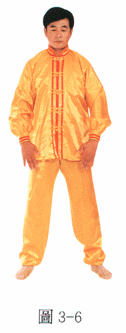 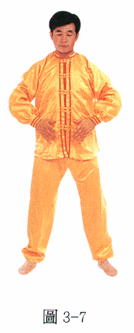 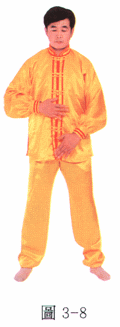
Turning the Law Wheel With Both Hands (Shuangshou Tuidong
Falun) – After the ninth two-handed gliding up and down movement,
move both hands downward past the head and over the chest until they reach the
lower abdominal area (Figure 3-7). Turn the Law Wheel with both hands (Figure
3-8, Figure 3-9). The left hand goes inside for males, and the right hand goes
inside for females. Keep a distance of about 2-3 cm (1 inch) between the
hands and also between the inner hand and the lower abdomen. Turn the Law Wheel
clockwise 4 times to spin the energy from the outside to the inside of the body.
While turning the Law Wheel, keep the hands within the area of the lower
abdomen.
Closing Position –
Liangshou Jieyin (Conjoin the hands) (Figure
3-10).
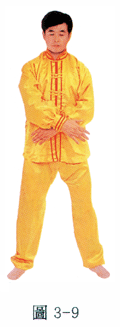 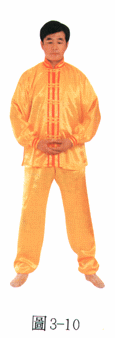
(Falun Zhoutian Fa)
Principle: Falun Cosmic Orbit enables the energy of the human body to
circulate over large areas—that is, not just in one or several meridians, but
from the entire yin side to the entire yang[41] side of the body, back and forth
continually. This exercise is far beyond the usual methods of opening the
meridians and the great and small cosmic orbits. Falun Cosmic Orbit is an
intermediate-level cultivation method. With the previous three exercises as a
base, the meridians of the entire body (including of the great cosmic orbit) can
be quickly opened through performing this exercise. From top to bottom, the
meridians will be gradually connected throughout the entire body. The most
outstanding feature of this exercise is its use of the Law Wheel’s rotation to
rectify all abnormal conditions in the human body. This enables the human body—a
small universe—to return to its original state and enables all meridians inside
the body to be unblocked. When this state is reached, you have achieved a very
high level in Triple-World-Law cultivation. When doing this exercise, both hands
follow the energy mechanisms. The movements are gradual, slow, and smooth.
Verse:
Xuanfa Zhixu[42]
Xinqing Siyu[43]
Fanben Guizhen[44]
Youyou Siqi[45]
Preparation – Stand naturally with feet shoulder-width apart. Bend both
knees slightly. Keep the knees and hips relaxed. Relax the whole body, but don’t
become too loose. Tuck the lower jaw in slightly. Touch the tip of the tongue to
the hard palate, leave a space between the upper and lower teeth, and close the
lips. Gently close the eyes. Maintain a serene expression on the face.
Conjoin the Hands (Liangshou Jieyin) –
(Figure 4-1)
Press the Hands Together in Front
of the Chest (Shuangshou
Heshi) – (Figure 4-2)
   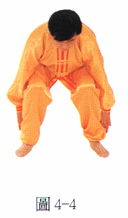
Separate the hands from Heshi. Move them
downward to the lower abdomen while turning both palms to face the body. Keep a
distance of no more than 10 cm (4 inches) between the hands and the body. After passing
the lower abdomen, extend the hands downward between the legs. Move the hands
downward with palms facing the inner sides of the legs and, at the same time,
bend at the waist and squat down (Figure 4-3). When the fingertips get close to
the ground, move the hands in a circle from the front of the feet, along the
outside of the feet to the heels (Figure 4-4). Bend both wrists slightly and
raise the hands along the backs of the legs (Figure 4-5). Straighten the waist
while lifting the hands up along the back (Figure 4-6).
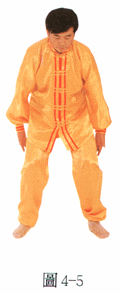 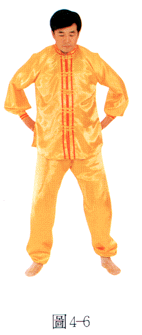 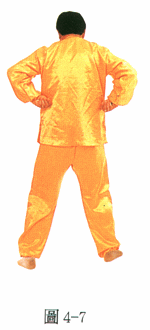 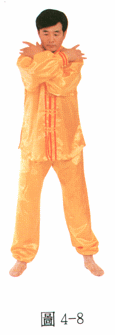
During the exercise, do not allow either hand to touch any
part of the body, or the energy on them will be taken back into the body. When
the hands cannot be lifted any higher along the back, make hollow fists (the
hands do not carry energy at that point) (Figure 4-7), then pull them forward
passing through the underarms. Cross the arms in front of the chest (There is no
special requirement for which arm is above or which arm is below—it depends on
what’s natural for you. This is the case for both males and females.) (Figure
4-8). Place the hands over the shoulders (leaving a space). Move both opened
palms along the yang (outer) sides of the arms. When reaching the wrists,
have the centers of both palms face each other at a distance of 3-4 cm (1 inch). At that
time, the hands and the arms should form a straight line (Figure 4-9). Without
pausing, turn both palms as if rotating a ball; that is, the outside hand should
end up inside, and the inside hand should end up outside. As both hands push
along the yin
(inner)
sides of the lower and upper arms, raise them up and over the back of the head
(Figure 4-10). The hands should form an “x” at the back of the head (Figure
4-11). Separate the hands, with the fingertips pointing downward, and connect
with the energy of the back. Then move both hands over the top of the head to
the front of the chest (Figure 4-12). This is one complete cosmic orbit. Repeat
the movements a total of nine times. After nine times, move the hands down along the chest to the lower abdomen.
Form Diekou Xiaofu
(Overlap the hands in front of the lower abdomen) (Figure
4-13).
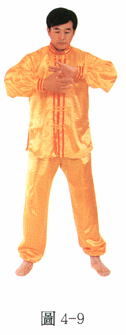 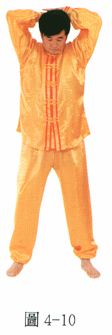  
Closing Position –
Liangshou Jieyin (Conjoin the hands) (Figure
4-14).
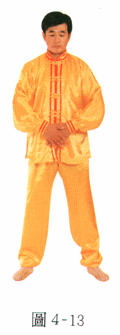 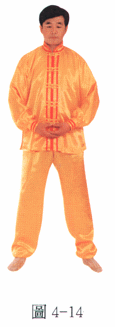
(Shentong Jiachi Fa)
Principle: Reinforcing
Supernatural Powers is a still cultivation exercise. It’s a multi-purpose
exercise that strengthens supernatural powers (including supernatural abilities)
and gong strength by turning the Law
Wheel using Buddha mudras, or hand
signs. This exercise is above the intermediate level and was originally a secret
exercise. Performing this exercise requires sitting in the full-lotus position.
The half-lotus position is acceptable at the initial stage if the full-lotus
position can’t be done. You eventually must sit in the full-lotus position.
During the exercise, the flow of energy is strong and the energy field around
the body is quite large. The longer the legs are crossed, the better. It depends
on your endurance. The longer you sit, the more intense the exercise and the
faster your gong grows. Don’t think
about anything when performing this exercise—no thought is involved. From a
state of calm enter into deep stillness (ding). But your main consciousness
must be aware that you are the one
who is doing the exercise.
Verse:
Youyi Wuyi[47]
Yinsui Jiqi[48]
Sikong Feikong[49]
Dongjing Ruyi[50]
Preparation – Sit with legs in
the lotus position. Keep the waist and neck upright. Tuck the lower jaw in
slightly. Touch the tip of the tongue to the hard palate, leave a space between
the upper and lower teeth, and close the lips. Keep the whole body relaxed, but
not too loose. Gently close the eyes. Compassion should arise in the heart, and
the facial expression should be peaceful.
Have
both hands in Jieyin at the lower
abdomen (Figure 5-1). Gradually enter into a state of calm.
  
Performing the Mudras
(Da Shouyin)[51] –
From
Jieyin, move the conjoined hands
slowly upward. When the hands are in front of the head, release Jieyin and gradually turn the palms
upward. When the palms are facing up the hands will have reached their highest
point (Figure 5-2). (When doing the mudras, the forearms lead the upper arms
with a certain amount of force.) Then separate the hands, turning them backwards
to draw an arc above the top of the head while bringing the hands down until
they’re in front of the
head (Figure 5-3). Have both palms face upward with the fingertips pointing
forward (Figure 5-4), and hold the elbows inward as much as possible. Straighten
the wrists while crossing them in front of the chest. For males, the left hand
moves outside; for females, the right hand moves outside. When both arms have
formed a horizontal line (Figure 5-5), turn the wrist of the outside hand
outward with the palm upward, drawing a semicircle. Have the palm facing up and
the fingertips pointing back. The hand should move with considerable force.
Meanwhile, from the position where the arms cross in front of the chest, bring
the hand of the inside arm slowly downward. When the hand is extended, turn the
palm to face forward. The lower hand should be positioned at a 30° angle from
the body (Figure 5-6). Next, turning both palms towards the body, move the left
hand
(the
upper hand) down on the inside and the right hand
upward.
Then repeat the previous movements using the opposite hands, switching the hand
positions (Figure 5-7). Next, males should straighten the right wrist (females,
the left wrist) and turn the palm to face the body. After crossing the hands in
front of the chest, extend the palm downward until the arm is straight and the
hand is over the lower leg. Males turn the left palm (females, the right palm)
inward and move it up. After crossing in front of the chest, move it towards the
front of the left shoulder (females, to the right shoulder). When the hand
reaches the position, have the palm facing up with the fingertips pointing
forward (Figure 5-8). Then, switch the hands’ positions using the previous
movements. That is, males should move the left hand (females, the right hand) on
the inside; the right hand for males (left hand for females) should move on the
outside. Switch the hand positions (Figure 5-9). When doing mudras, the movements are continuous,
without interruption.
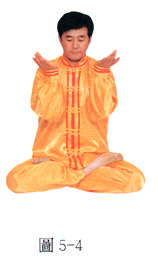  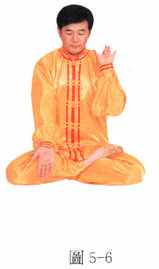
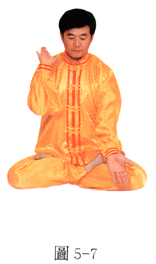 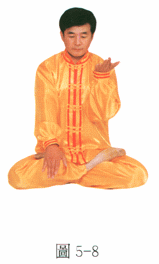 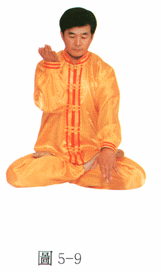
Reinforcing (Jiachi) – Following
the previous hand movements, move the upper hand along the inside, and the lower
hand along the outside. Males, turn the right hand,
moving
it downward with the palm facing the chest. Males, lift the left hand (females,
the right hand) upward. When both forearms reach the chest and form a horizontal
line (Figure 5-10), extend the hands out to the sides while turning the palms
downward (Figure 5-11).
 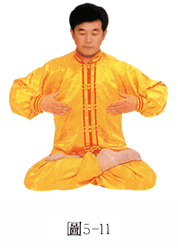
When the hands are above knee level and extended out, keep
the hands at waist level, with the forearms and the backs of the hands at the
same level and with both arms relaxed (Figure 5-12). This position delivers
supernatural powers from inside the body to the hands for reinforcing. When
reinforcing, the palms will feel warm, heavy, electric, numb, as if holding a
weight, etc. But don’t pursue these sensations—just let them happen naturally.
The longer this position is held, the better.
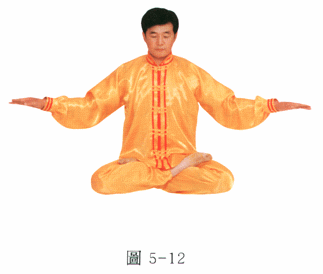 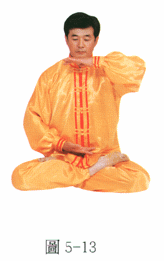
Males, hook the wrist of the right hand (females, the left
hand) to turn the palm to face inwards while moving the hand towards the lower
abdomen. After reaching the lower abdomen, the palm should face up. At the same
time, males should turn the left hand (females, the right hand) forward while
lifting it towards the chin. When the arm reaches the same level as the
shoulders, the palm should face down. After reaching the proper position, the
forearm and the hand ought to be horizontal. With the centers of both palms
facing each other, settle into this position (Figure 5-13). The strengthening
positions need to be held for a long time, but you may hold them as long as you
can. Next, have the upper hand draw a half circle forward and down to the lower
abdominal area. At the same time, lift the lower hand upward while turning the
palm downward. When it reaches the chin, the arm should be at the same level as
the shoulders. With the centers of both palms facing each other, settle into
this position (Figure 5-14). The longer this is held, the better.
 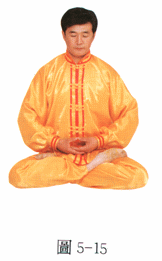 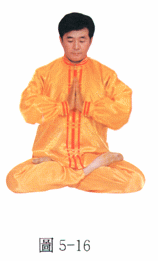
Still
Cultivation (Jinggong Xiulian) –
Starting
from the previous position, have the upper hand draw a half circle forward and
down to the lower abdomen, and form Jieyin with the hands (Figure 5-15).
Enter into still cultivation. Go into deep stillness, but make sure your main consciousness
knows you are doing the exercise. The longer you meditate, the better—meditate
for as long as you can.
Closing Position –
Move
the hands to Heshi, and come out of
stillness.
Take your legs out of the lotus position.
[2] The verses are recited once only, in Chinese, right before each
exercise. Each exercise has its own specific verse that you may recite out loud
or just listen to on the exercise tape.
The hand position to
maintain throughout the exercises whenever the hands are apart. In this
position, the palms are open and the fingers are relaxed, but straight. The
middle finger of each hand is relaxed so that it bends slightly towards the
center of the palm.
[41] (“yin, yahng”) In Chinese thought, two
opposite, but complementary primal forces which are present in all life and
matter. For example, female (yin) vs. male (yang), front of
the body (yin) vs. back of the body (yang).
  
|